ESP VOLVO XC60 TWIN ENGINE 2019 Owners Manual
[x] Cancel search | Manufacturer: VOLVO, Model Year: 2019, Model line: XC60 TWIN ENGINE, Model: VOLVO XC60 TWIN ENGINE 2019Pages: 695, PDF Size: 14.96 MB
Page 601 of 695
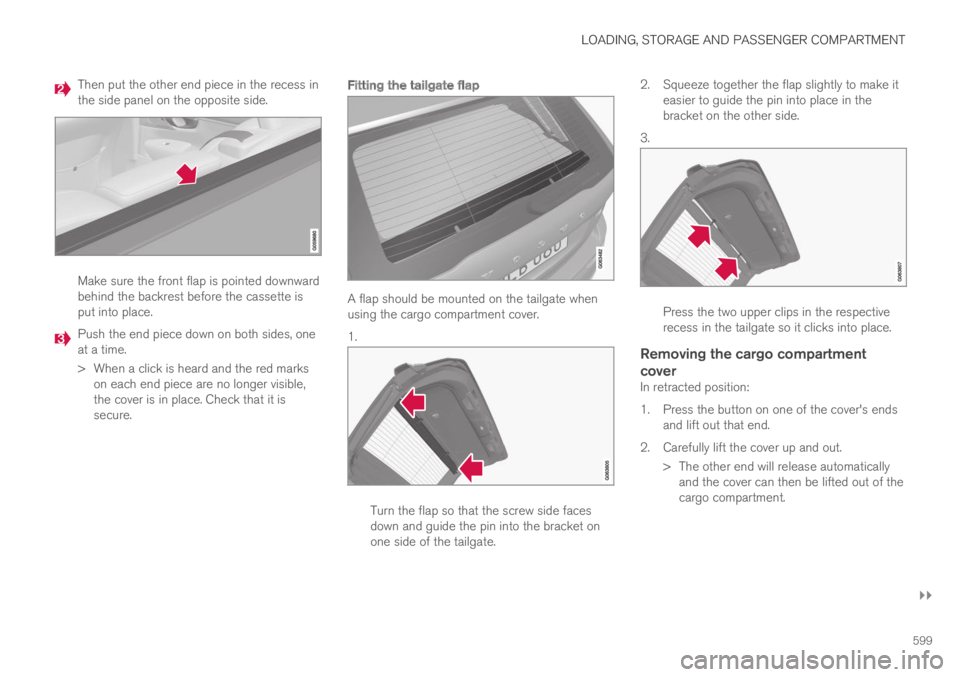
LOADING, STORAGE AND PASSENGER COMPARTMENT
}}
599
Then put the other end piece in the recess inthe side panel on the opposite side.
Make sure the front flap is pointed downwardbehind the backrest before the cassette isput into place.
Push the end piece down on both sides, oneat a time.
>When a click is heard and the red markson each end piece are no longer visible,the cover is in place. Check that it issecure.
Fitting the tailgate flap
A flap should be mounted on the tailgate whenusing the cargo compartment cover.
1.
Turn the flap so that the screw side facesdown and guide the pin into the bracket onone side of the tailgate.
2.Squeeze together the flap slightly to make iteasier to guide the pin into place in thebracket on the other side.
3.
Press the two upper clips in the respectiverecess in the tailgate so it clicks into place.
Removing the cargo compartment
cover
In retracted position:
1. Press the button on one of the cover's endsand lift out that end.
2. Carefully lift the cover up and out.
> The other end will release automaticallyand the cover can then be lifted out of thecargo compartment.
Page 606 of 695
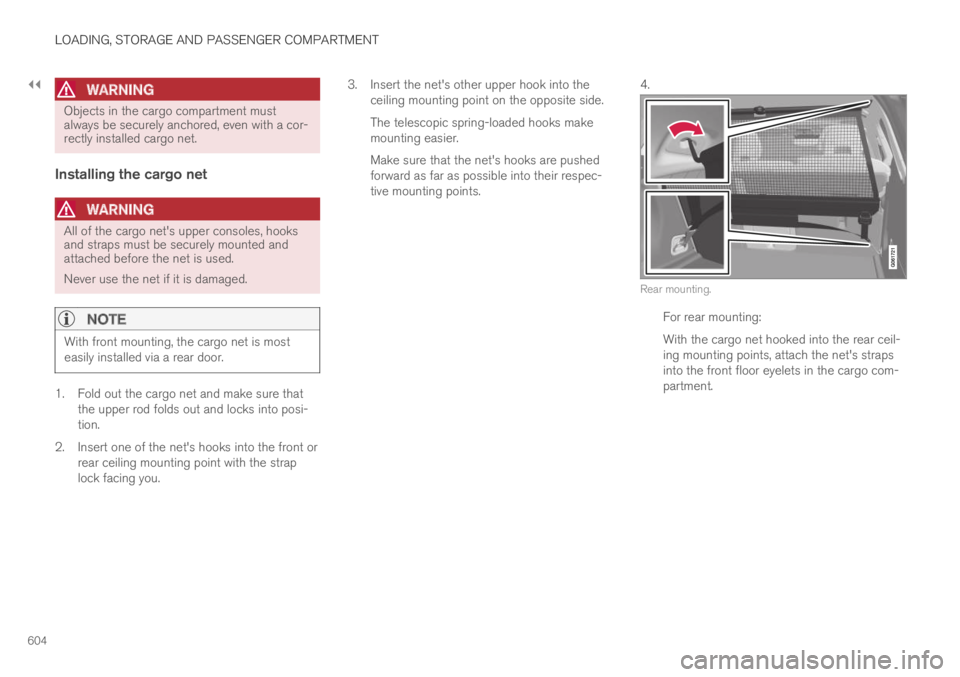
||
LOADING, STORAGE AND PASSENGER COMPARTMENT
604
WARNING
Objects in the cargo compartment mustalways be securely anchored, even with a cor-rectly installed cargo net.
Installing the cargo net
WARNING
All of the cargo net's upper consoles, hooksand straps must be securely mounted andattached before the net is used.
Never use the net if it is damaged.
NOTE
With front mounting, the cargo net is mosteasily installed via a rear door.
1. Fold out the cargo net and make sure thatthe upper rod folds out and locks into posi-tion.
2.Insert one of the net's hooks into the front orrear ceiling mounting point with the straplock facing you.
3. Insert the net's other upper hook into theceiling mounting point on the opposite side.
The telescopic spring-loaded hooks makemounting easier.
Make sure that the net's hooks are pushedforward as far as possible into their respec-tive mounting points.
4.
Rear mounting.
For rear mounting:
With the cargo net hooked into the rear ceil-ing mounting points, attach the net's strapsinto the front floor eyelets in the cargo com-partment.
Page 616 of 695
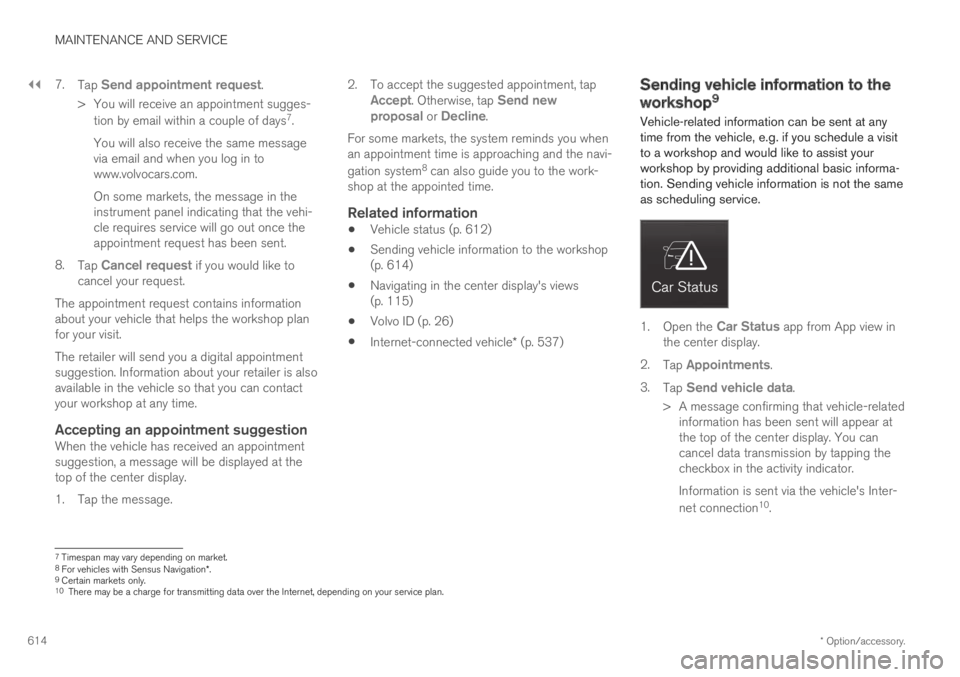
||
MAINTENANCE AND SERVICE
* Option/accessory.614
7.Tap Send appointment request.
>You will receive an appointment sugges-
tion by email within a couple of days7.
You will also receive the same messagevia email and when you log in towww.volvocars.com.
On some markets, the message in theinstrument panel indicating that the vehi-cle requires service will go out once theappointment request has been sent.
8.Tap Cancel request if you would like tocancel your request.
The appointment request contains informationabout your vehicle that helps the workshop planfor your visit.
The retailer will send you a digital appointmentsuggestion. Information about your retailer is alsoavailable in the vehicle so that you can contactyour workshop at any time.
Accepting an appointment suggestion
When the vehicle has received an appointmentsuggestion, a message will be displayed at thetop of the center display.
1. Tap the message.
2. To accept the suggested appointment, tapAccept. Otherwise, tap Send newproposal or Decline.
For some markets, the system reminds you whenan appointment time is approaching and the navi-
gation system8 can also guide you to the work-shop at the appointed time.
Related information
Vehicle status (p. 612)
Sending vehicle information to the workshop(p. 614)
Navigating in the center display's views(p. 115)
Volvo ID (p. 26)
Internet-connected vehicle* (p. 537)
Sending vehicle information to the
workshop9
Vehicle-related information can be sent at anytime from the vehicle, e.g. if you schedule a visitto a workshop and would like to assist yourworkshop by providing additional basic informa-tion. Sending vehicle information is not the sameas scheduling service.
1.Open the Car Status app from App view inthe center display.
2.Tap Appointments.
3.Tap Send vehicle data.
>A message confirming that vehicle-relatedinformation has been sent will appear atthe top of the center display. You cancancel data transmission by tapping thecheckbox in the activity indicator.
Information is sent via the vehicle's Inter-
net connection10.
7Timespan may vary depending on market.8For vehicles with Sensus Navigation*.9Certain markets only.10There may be a charge for transmitting data over the Internet, depending on your service plan.
Page 632 of 695
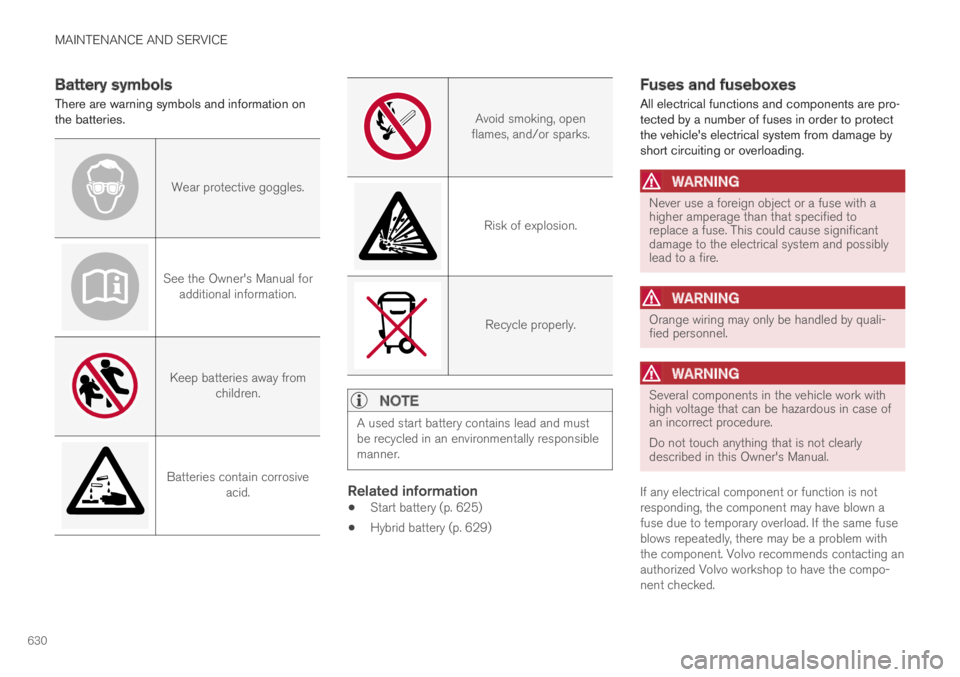
MAINTENANCE AND SERVICE
630
Battery symbols
There are warning symbols and information onthe batteries.
Wear protective goggles.
See the Owner's Manual foradditional information.
Keep batteries away fromchildren.
Batteries contain corrosiveacid.
Avoid smoking, openflames, and/or sparks.
Risk of explosion.
Recycle properly.
NOTE
A used start battery contains lead and mustbe recycled in an environmentally responsiblemanner.
Related information
Start battery (p. 625)
Hybrid battery (p. 629)
Fuses and fuseboxes
All electrical functions and components are pro-tected by a number of fuses in order to protectthe vehicle's electrical system from damage byshort circuiting or overloading.
WARNING
Never use a foreign object or a fuse with ahigher amperage than that specified toreplace a fuse. This could cause significantdamage to the electrical system and possiblylead to a fire.
WARNING
Orange wiring may only be handled by quali-fied personnel.
WARNING
Several components in the vehicle work withhigh voltage that can be hazardous in case ofan incorrect procedure.
Do not touch anything that is not clearlydescribed in this Owner's Manual.
If any electrical component or function is notresponding, the component may have blown afuse due to temporary overload. If the same fuseblows repeatedly, there may be a problem withthe component. Volvo recommends contacting anauthorized Volvo workshop to have the compo-nent checked.
Page 649 of 695
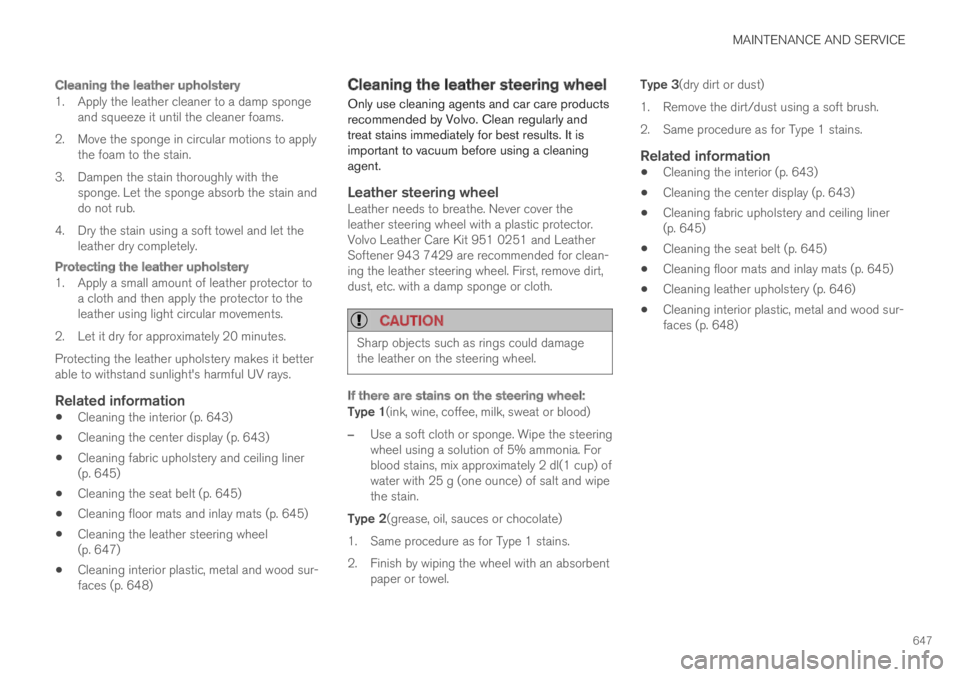
MAINTENANCE AND SERVICE
647
Cleaning the leather upholstery
1. Apply the leather cleaner to a damp spongeand squeeze it until the cleaner foams.
2. Move the sponge in circular motions to applythe foam to the stain.
3. Dampen the stain thoroughly with thesponge. Let the sponge absorb the stain anddo not rub.
4. Dry the stain using a soft towel and let theleather dry completely.
Protecting the leather upholstery
1. Apply a small amount of leather protector toa cloth and then apply the protector to theleather using light circular movements.
2. Let it dry for approximately 20 minutes.
Protecting the leather upholstery makes it betterable to withstand sunlight's harmful UV rays.
Related information
Cleaning the interior (p. 643)
Cleaning the center display (p. 643)
Cleaning fabric upholstery and ceiling liner(p. 645)
Cleaning the seat belt (p. 645)
Cleaning floor mats and inlay mats (p. 645)
Cleaning the leather steering wheel(p. 647)
Cleaning interior plastic, metal and wood sur-faces (p. 648)
Cleaning the leather steering wheel
Only use cleaning agents and car care productsrecommended by Volvo. Clean regularly andtreat stains immediately for best results. It isimportant to vacuum before using a cleaningagent.
Leather steering wheel
Leather needs to breathe. Never cover theleather steering wheel with a plastic protector.Volvo Leather Care Kit 951 0251 and LeatherSoftener 943 7429 are recommended for clean-ing the leather steering wheel. First, remove dirt,dust, etc. with a damp sponge or cloth.
CAUTION
Sharp objects such as rings could damagethe leather on the steering wheel.
If there are stains on the steering wheel:
Type 1(ink, wine, coffee, milk, sweat or blood)
–Use a soft cloth or sponge. Wipe the steeringwheel using a solution of 5% ammonia. Forblood stains, mix approximately 2 dl(1 cup) ofwater with 25 g (one ounce) of salt and wipethe stain.
Type 2(grease, oil, sauces or chocolate)
1.Same procedure as for Type 1 stains.
2. Finish by wiping the wheel with an absorbentpaper or towel.
Type 3(dry dirt or dust)
1. Remove the dirt/dust using a soft brush.
2. Same procedure as for Type 1 stains.
Related information
Cleaning the interior (p. 643)
Cleaning the center display (p. 643)
Cleaning fabric upholstery and ceiling liner(p. 645)
Cleaning the seat belt (p. 645)
Cleaning floor mats and inlay mats (p. 645)
Cleaning leather upholstery (p. 646)
Cleaning interior plastic, metal and wood sur-faces (p. 648)
Page 652 of 695
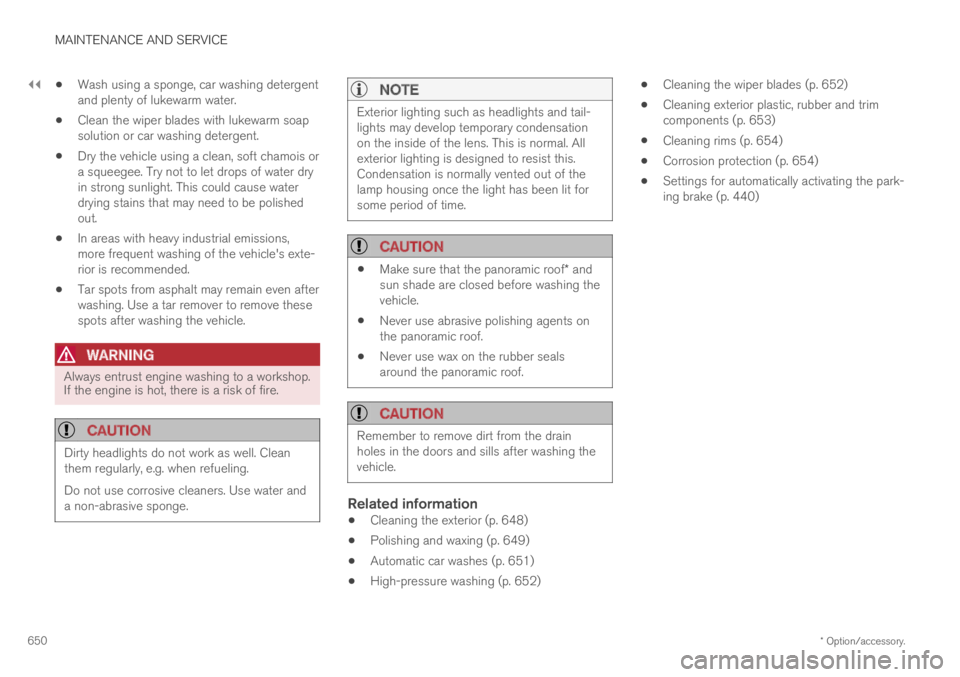
||
MAINTENANCE AND SERVICE
* Option/accessory.650
Wash using a sponge, car washing detergentand plenty of lukewarm water.
Clean the wiper blades with lukewarm soapsolution or car washing detergent.
Dry the vehicle using a clean, soft chamois ora squeegee. Try not to let drops of water dryin strong sunlight. This could cause waterdrying stains that may need to be polishedout.
In areas with heavy industrial emissions,more frequent washing of the vehicle's exte-rior is recommended.
Tar spots from asphalt may remain even afterwashing. Use a tar remover to remove thesespots after washing the vehicle.
WARNING
Always entrust engine washing to a workshop.If the engine is hot, there is a risk of fire.
CAUTION
Dirty headlights do not work as well. Cleanthem regularly, e.g. when refueling.
Do not use corrosive cleaners. Use water anda non-abrasive sponge.
NOTE
Exterior lighting such as headlights and tail-lights may develop temporary condensationon the inside of the lens. This is normal. Allexterior lighting is designed to resist this.Condensation is normally vented out of thelamp housing once the light has been lit forsome period of time.
CAUTION
Make sure that the panoramic roof* andsun shade are closed before washing thevehicle.
Never use abrasive polishing agents onthe panoramic roof.
Never use wax on the rubber sealsaround the panoramic roof.
CAUTION
Remember to remove dirt from the drainholes in the doors and sills after washing thevehicle.
Related information
Cleaning the exterior (p. 648)
Polishing and waxing (p. 649)
Automatic car washes (p. 651)
High-pressure washing (p. 652)
Cleaning the wiper blades (p. 652)
Cleaning exterior plastic, rubber and trimcomponents (p. 653)
Cleaning rims (p. 654)
Corrosion protection (p. 654)
Settings for automatically activating the park-ing brake (p. 440)
Page 665 of 695
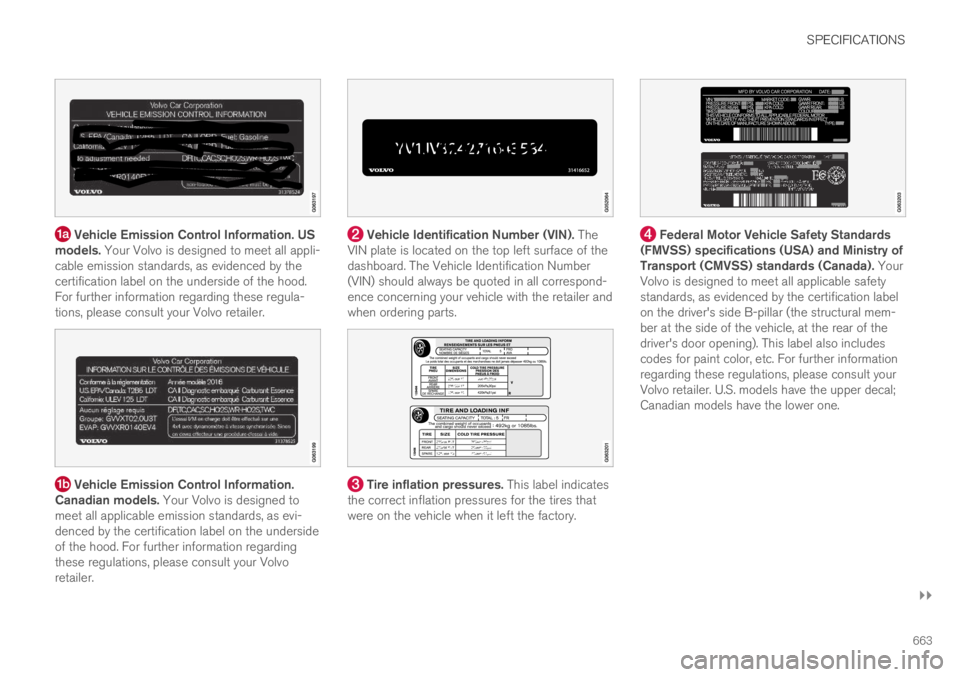
SPECIFICATIONS
}}
663
Vehicle Emission Control Information. USmodels. Your Volvo is designed to meet all appli-cable emission standards, as evidenced by thecertification label on the underside of the hood.For further information regarding these regula-tions, please consult your Volvo retailer.
Vehicle Emission Control Information.Canadian models. Your Volvo is designed tomeet all applicable emission standards, as evi-denced by the certification label on the undersideof the hood. For further information regardingthese regulations, please consult your Volvoretailer.
Vehicle Identification Number (VIN). TheVIN plate is located on the top left surface of thedashboard. The Vehicle Identification Number(VIN) should always be quoted in all correspond-ence concerning your vehicle with the retailer andwhen ordering parts.
Tire inflation pressures. This label indicatesthe correct inflation pressures for the tires thatwere on the vehicle when it left the factory.
Federal Motor Vehicle Safety Standards(FMVSS) specifications (USA) and Ministry ofTransport (CMVSS) standards (Canada). YourVolvo is designed to meet all applicable safetystandards, as evidenced by the certification labelon the driver's side B-pillar (the structural mem-ber at the side of the vehicle, at the rear of thedriver's door opening). This label also includescodes for paint color, etc. For further informationregarding these regulations, please consult yourVolvo retailer. U.S. models have the upper decal;Canadian models have the lower one.
Page 671 of 695

SPECIFICATIONS
669
Engine specifications
Engine specifications (output, etc.) for eachengine variant are shown in the table below. Thespecifications for Special Edition vehicles mayvary.
Twin Engine vehicles are powered by both agasoline engine and an electric motor (ERAD –Electric Rear Axle Drive).
NOTE
Not all engines are available on all markets.
EngineEngine codeAOutput
(kW/rps)
Output
(hp/rpm)
Torque
(Nm/rps)
Torque
(ft. lbs./rpm)
Number of cylinders
T8 Twin EngineB4204T28 233/100 313/6000 400/37–90 295/2200–54004
AThe engine code, component and manufacturer serial numbers can be found on the engine.
Electric motor
Max. output: 65 kW (87 hp).
Torque: 240 Nm.
Related information
Type designations (p. 662)
Engine oil specifications (p. 670)
Coolant specifications (p. 671)